Economics for Business: Reforms in the Australian Tourism Industry
VerifiedAdded on 2020/02/23
|8
|1508
|90
Report
AI Summary
This report provides an economic analysis of the Australian tourism industry, focusing on its growth, challenges, and proposed reforms. It highlights the industry's increasing importance to the Australian economy, surpassing the mining sector in employment and export volume. The report examines the rise in international tourism, particularly from Asian markets, and identifies the economic impact of these trends. It also discusses the Tourism 2020 plan, outlining strategies to double overnight visitor spending, including investments in marketing, infrastructure, and workforce development. Recommendations include innovative marketing techniques, increased aviation capacity, improved visa processing, and integration of state and national tourism agendas to boost the industry's potential.
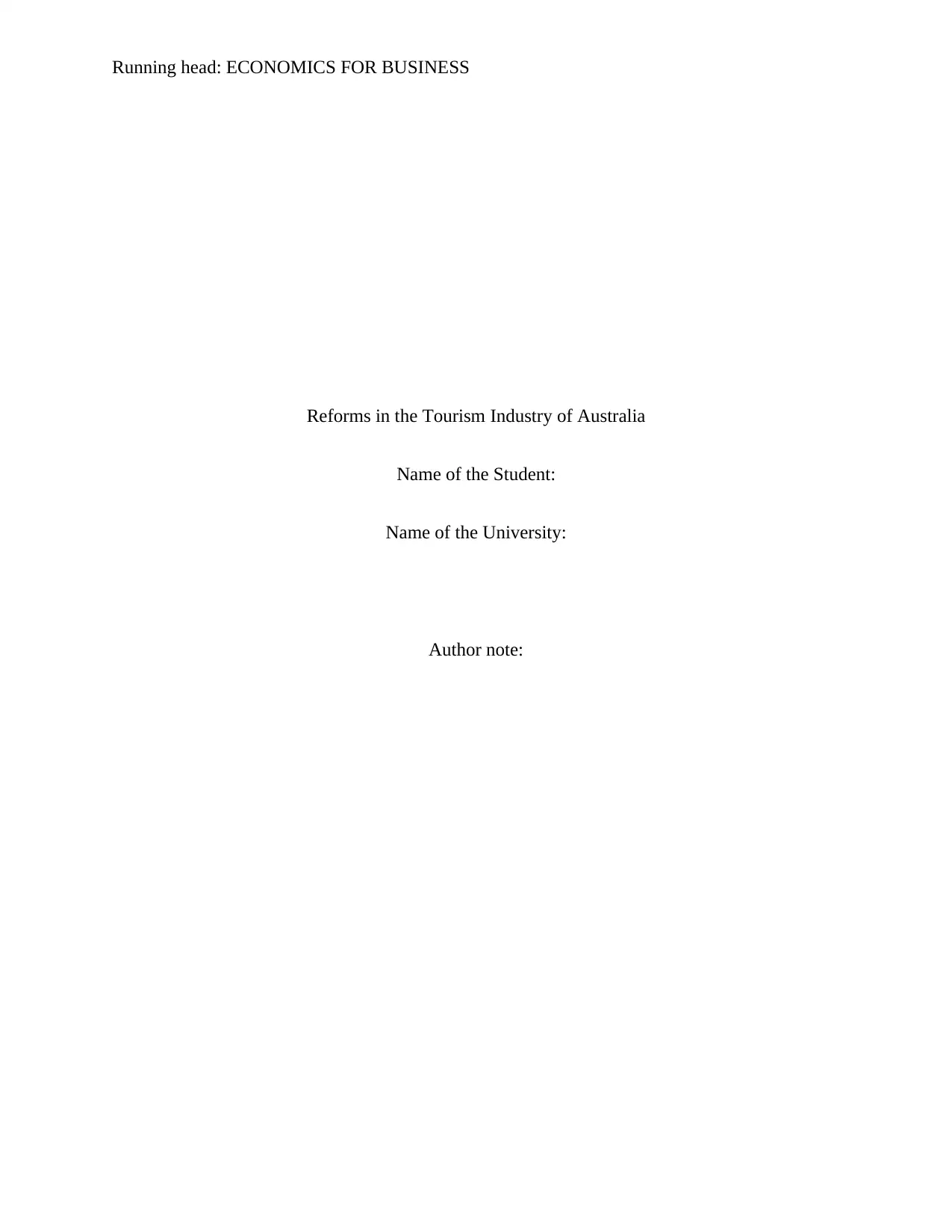
Running head: ECONOMICS FOR BUSINESS
Reforms in the Tourism Industry of Australia
Name of the Student:
Name of the University:
Author note:
Reforms in the Tourism Industry of Australia
Name of the Student:
Name of the University:
Author note:
Paraphrase This Document
Need a fresh take? Get an instant paraphrase of this document with our AI Paraphraser

1ECONOMICS FOR BUSINESS
Trends in the tourism industry of Australia
The Daily Telegraph of Australia has published a report on October 16, 2015 by Ann
Sherry, on an issue faced by the tourism industry of the country. Sherry wrote that one of the
biggest industries of Australia requires big ideas and innovation for further growth and
development. She highlighted that as the most important sector in Australia, i.e. the resource
sector, is faltering in contributing in the country’s growth; the tourism sector has come up as the
next best industry. This industry is becoming an economic powerhouse for the next decades to
come, with a potential to add almost $250 billion in the economy in the next 20 years. The
volume of employment in tourism industry is much higher than in the mining industry. It has
been found that in 2013-14, there were 530,000 people employed in tourism in comparison to
only 270,000 in the mining. The export volume of tourism has exceeded that of coal. In May
2014, coal earned $16.5 billion from export, while tourism brought about $17 billion. Among the
states and territories of Australia, NSW has huge potential for visitor economy, as it supports
90,000 tourism businesses and employs 159,000 direct jobs, contributing $11 billion in the Gross
State Product (Sherry, 2015).
Following the scopes for growing tourism activities, the NSW government is keen on
utilizing the resources for further development of Sydney. Sydney is already a global city and a
popular destination for tourists. However, the government wants to make it a city where people
would want to live and visit, easier to navigate, has world class facilities and has vibrancy and
energy to attract the people. Sherry proposes that to increase the tourist footfalls in NSW and in
whole Australia, the government needs to implement innovative and big ideas, which would
make the existing items more attractive. In this context, she has provided the example of High
Trends in the tourism industry of Australia
The Daily Telegraph of Australia has published a report on October 16, 2015 by Ann
Sherry, on an issue faced by the tourism industry of the country. Sherry wrote that one of the
biggest industries of Australia requires big ideas and innovation for further growth and
development. She highlighted that as the most important sector in Australia, i.e. the resource
sector, is faltering in contributing in the country’s growth; the tourism sector has come up as the
next best industry. This industry is becoming an economic powerhouse for the next decades to
come, with a potential to add almost $250 billion in the economy in the next 20 years. The
volume of employment in tourism industry is much higher than in the mining industry. It has
been found that in 2013-14, there were 530,000 people employed in tourism in comparison to
only 270,000 in the mining. The export volume of tourism has exceeded that of coal. In May
2014, coal earned $16.5 billion from export, while tourism brought about $17 billion. Among the
states and territories of Australia, NSW has huge potential for visitor economy, as it supports
90,000 tourism businesses and employs 159,000 direct jobs, contributing $11 billion in the Gross
State Product (Sherry, 2015).
Following the scopes for growing tourism activities, the NSW government is keen on
utilizing the resources for further development of Sydney. Sydney is already a global city and a
popular destination for tourists. However, the government wants to make it a city where people
would want to live and visit, easier to navigate, has world class facilities and has vibrancy and
energy to attract the people. Sherry proposes that to increase the tourist footfalls in NSW and in
whole Australia, the government needs to implement innovative and big ideas, which would
make the existing items more attractive. In this context, she has provided the example of High

2ECONOMICS FOR BUSINESS
Line public park in Manhattan. The authority has converted the crumbling infrastructure into an
innovative popular tourist destination for the locals and international visitors (Schratz, 2013).
Economic analysis of the tourism industry of Australia
The international tourism industry of Australia has grown and developed significantly
over the last two decades. In 1992, the number of international tourists to Australia was only 2.5
million to almost 6.7 million in 2014, which is more than double. The composition of the
industry has changed too. The markets of Asia, specifically China and India, has gained
importance as an international source for visitors. New Zealand is the biggest source of tourists,
followed by China (Pc.gov.au, 2015). This increase in tourism results in more stronger ties
between the countries. However, there has been decline in the number of tourists from some
politically and economically strong countries, such as, USA, UK and Japan. The political and
economic conditions between Australia and other countries influence the volume and nature of
tourism, like in any other services. The global market share of Australia for international tourism
has declined by 0.6% in 2013 due to the fall in the number of tourists from these first world
countries (Austrade.gov.au, 2017).
Line public park in Manhattan. The authority has converted the crumbling infrastructure into an
innovative popular tourist destination for the locals and international visitors (Schratz, 2013).
Economic analysis of the tourism industry of Australia
The international tourism industry of Australia has grown and developed significantly
over the last two decades. In 1992, the number of international tourists to Australia was only 2.5
million to almost 6.7 million in 2014, which is more than double. The composition of the
industry has changed too. The markets of Asia, specifically China and India, has gained
importance as an international source for visitors. New Zealand is the biggest source of tourists,
followed by China (Pc.gov.au, 2015). This increase in tourism results in more stronger ties
between the countries. However, there has been decline in the number of tourists from some
politically and economically strong countries, such as, USA, UK and Japan. The political and
economic conditions between Australia and other countries influence the volume and nature of
tourism, like in any other services. The global market share of Australia for international tourism
has declined by 0.6% in 2013 due to the fall in the number of tourists from these first world
countries (Austrade.gov.au, 2017).
⊘ This is a preview!⊘
Do you want full access?
Subscribe today to unlock all pages.

Trusted by 1+ million students worldwide
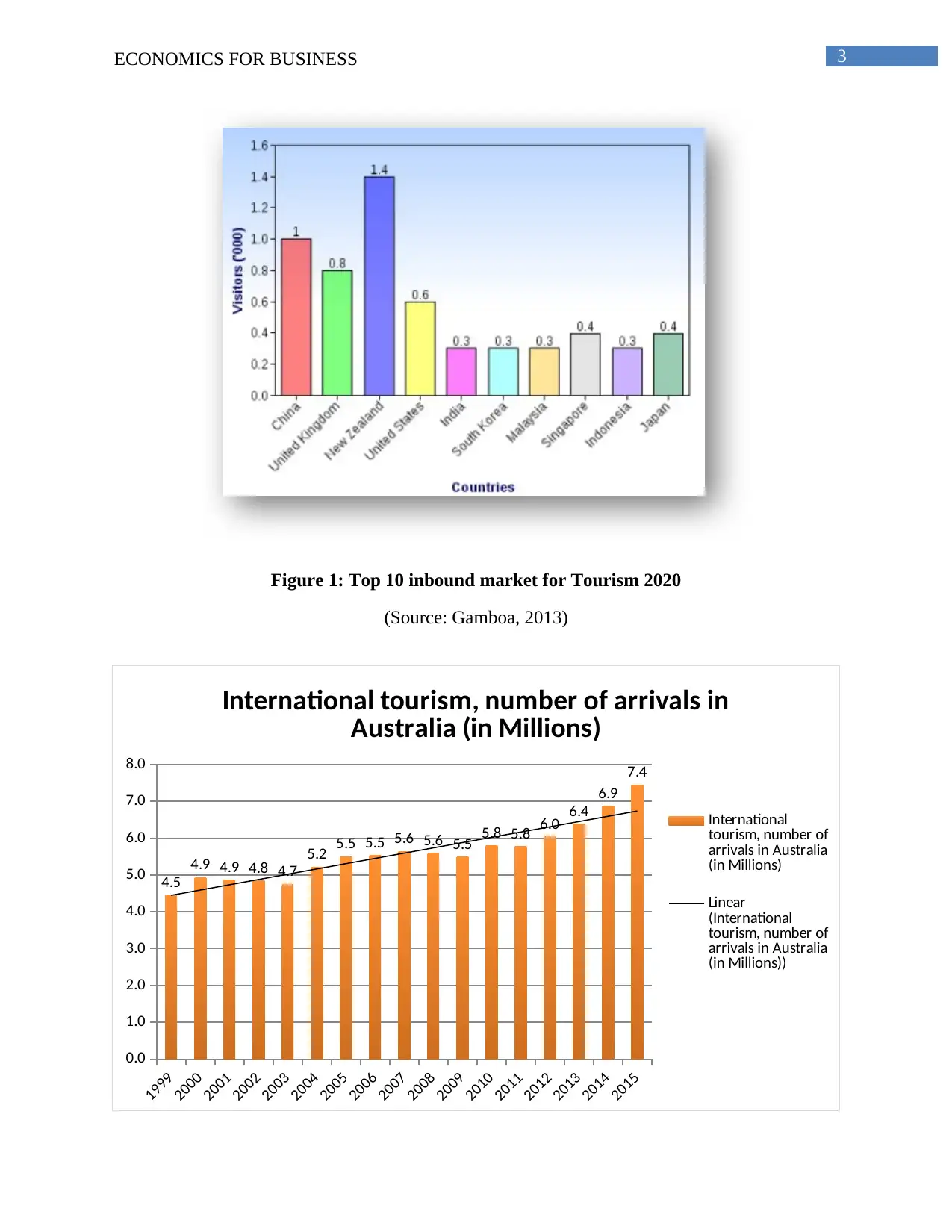
3ECONOMICS FOR BUSINESS
Figure 1: Top 10 inbound market for Tourism 2020
(Source: Gamboa, 2013)
1999
2000
2001
2002
2003
2004
2005
2006
2007
2008
2009
2010
2011
2012
2013
2014
2015
0.0
1.0
2.0
3.0
4.0
5.0
6.0
7.0
8.0
4.5
4.9 4.9 4.8 4.7
5.2 5.5 5.5 5.6 5.6 5.5 5.8 5.8 6.0 6.4
6.9
7.4
International tourism, number of arrivals in
Australia (in Millions)
International
tourism, number of
arrivals in Australia
(in Millions)
Linear
(International
tourism, number of
arrivals in Australia
(in Millions))
Figure 1: Top 10 inbound market for Tourism 2020
(Source: Gamboa, 2013)
1999
2000
2001
2002
2003
2004
2005
2006
2007
2008
2009
2010
2011
2012
2013
2014
2015
0.0
1.0
2.0
3.0
4.0
5.0
6.0
7.0
8.0
4.5
4.9 4.9 4.8 4.7
5.2 5.5 5.5 5.6 5.6 5.5 5.8 5.8 6.0 6.4
6.9
7.4
International tourism, number of arrivals in
Australia (in Millions)
International
tourism, number of
arrivals in Australia
(in Millions)
Linear
(International
tourism, number of
arrivals in Australia
(in Millions))
Paraphrase This Document
Need a fresh take? Get an instant paraphrase of this document with our AI Paraphraser
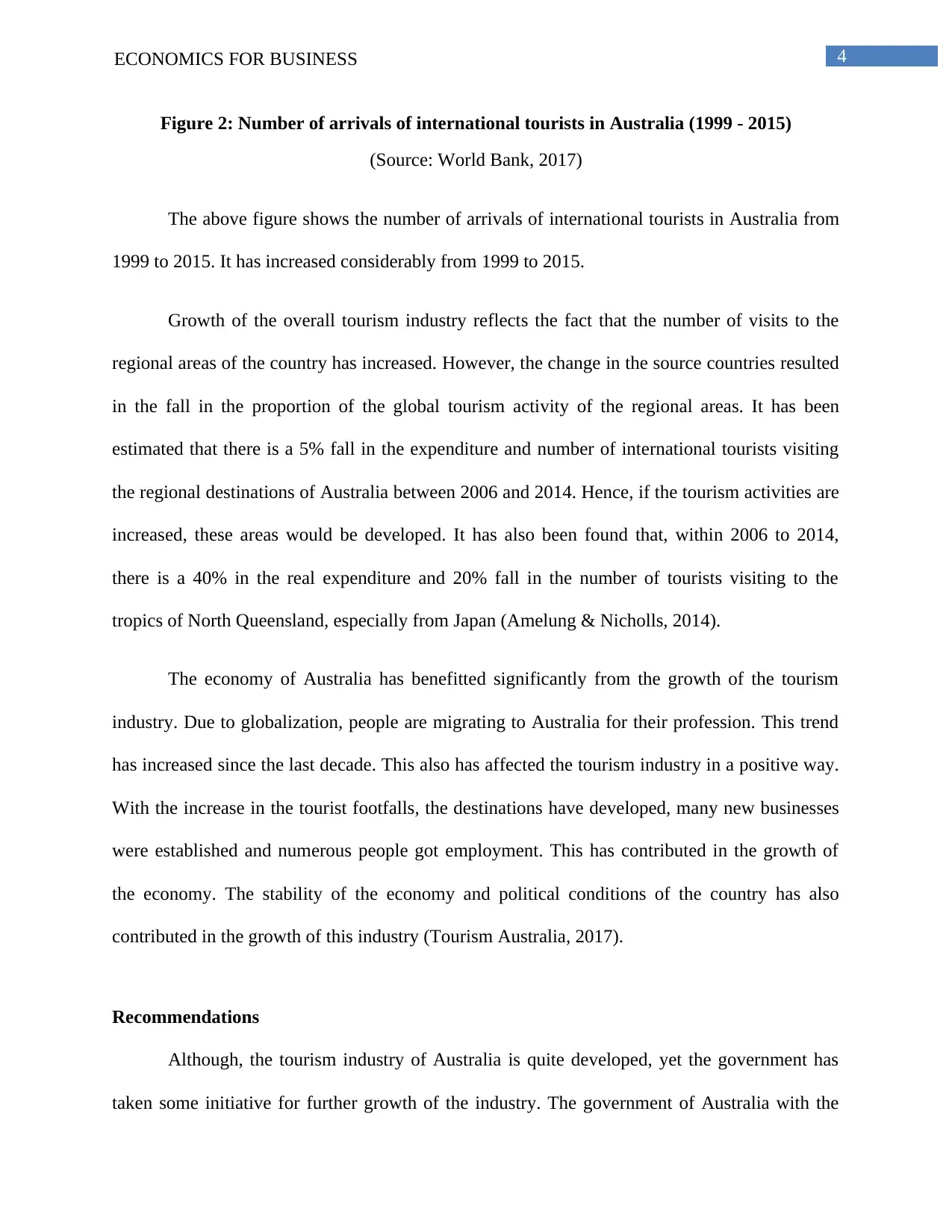
4ECONOMICS FOR BUSINESS
Figure 2: Number of arrivals of international tourists in Australia (1999 - 2015)
(Source: World Bank, 2017)
The above figure shows the number of arrivals of international tourists in Australia from
1999 to 2015. It has increased considerably from 1999 to 2015.
Growth of the overall tourism industry reflects the fact that the number of visits to the
regional areas of the country has increased. However, the change in the source countries resulted
in the fall in the proportion of the global tourism activity of the regional areas. It has been
estimated that there is a 5% fall in the expenditure and number of international tourists visiting
the regional destinations of Australia between 2006 and 2014. Hence, if the tourism activities are
increased, these areas would be developed. It has also been found that, within 2006 to 2014,
there is a 40% in the real expenditure and 20% fall in the number of tourists visiting to the
tropics of North Queensland, especially from Japan (Amelung & Nicholls, 2014).
The economy of Australia has benefitted significantly from the growth of the tourism
industry. Due to globalization, people are migrating to Australia for their profession. This trend
has increased since the last decade. This also has affected the tourism industry in a positive way.
With the increase in the tourist footfalls, the destinations have developed, many new businesses
were established and numerous people got employment. This has contributed in the growth of
the economy. The stability of the economy and political conditions of the country has also
contributed in the growth of this industry (Tourism Australia, 2017).
Recommendations
Although, the tourism industry of Australia is quite developed, yet the government has
taken some initiative for further growth of the industry. The government of Australia with the
Figure 2: Number of arrivals of international tourists in Australia (1999 - 2015)
(Source: World Bank, 2017)
The above figure shows the number of arrivals of international tourists in Australia from
1999 to 2015. It has increased considerably from 1999 to 2015.
Growth of the overall tourism industry reflects the fact that the number of visits to the
regional areas of the country has increased. However, the change in the source countries resulted
in the fall in the proportion of the global tourism activity of the regional areas. It has been
estimated that there is a 5% fall in the expenditure and number of international tourists visiting
the regional destinations of Australia between 2006 and 2014. Hence, if the tourism activities are
increased, these areas would be developed. It has also been found that, within 2006 to 2014,
there is a 40% in the real expenditure and 20% fall in the number of tourists visiting to the
tropics of North Queensland, especially from Japan (Amelung & Nicholls, 2014).
The economy of Australia has benefitted significantly from the growth of the tourism
industry. Due to globalization, people are migrating to Australia for their profession. This trend
has increased since the last decade. This also has affected the tourism industry in a positive way.
With the increase in the tourist footfalls, the destinations have developed, many new businesses
were established and numerous people got employment. This has contributed in the growth of
the economy. The stability of the economy and political conditions of the country has also
contributed in the growth of this industry (Tourism Australia, 2017).
Recommendations
Although, the tourism industry of Australia is quite developed, yet the government has
taken some initiative for further growth of the industry. The government of Australia with the
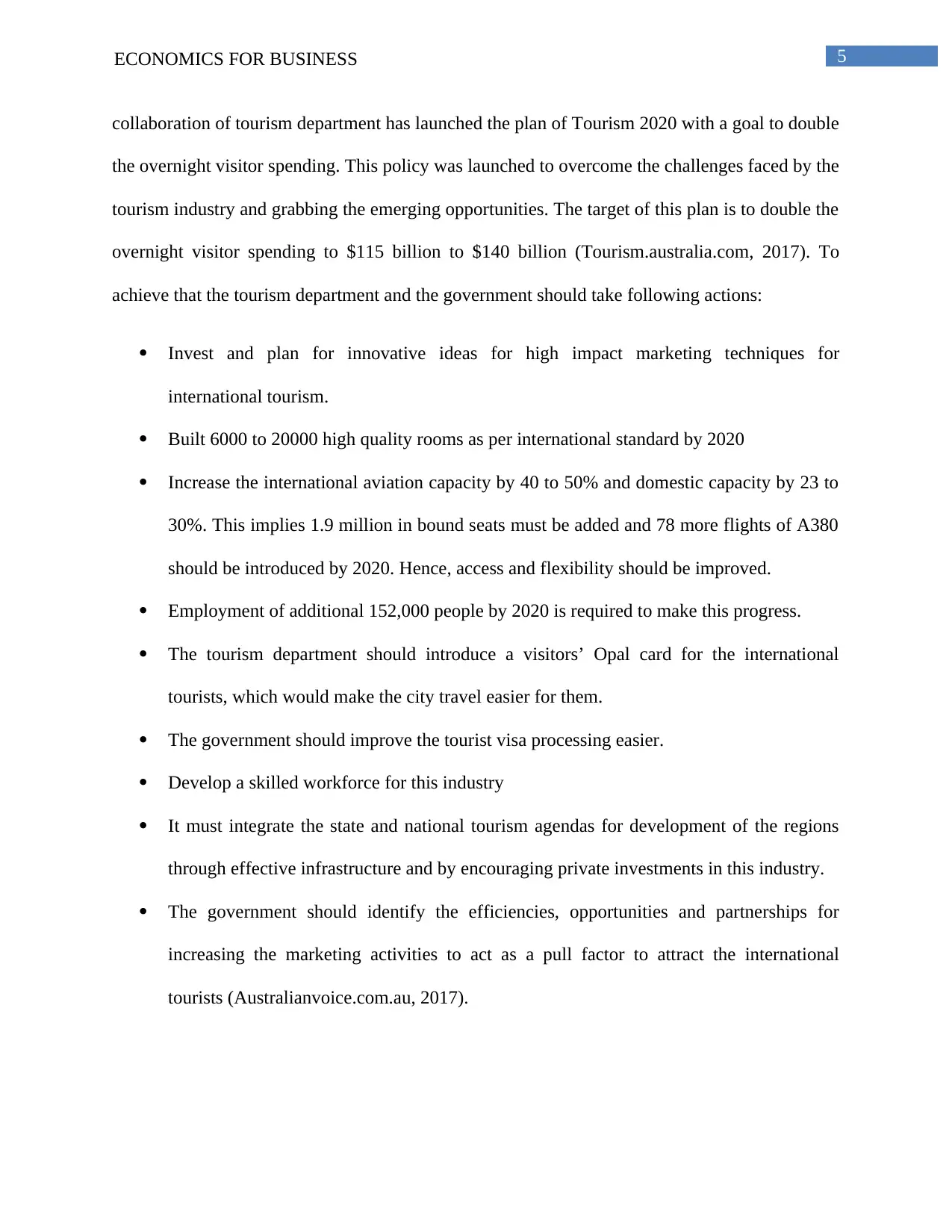
5ECONOMICS FOR BUSINESS
collaboration of tourism department has launched the plan of Tourism 2020 with a goal to double
the overnight visitor spending. This policy was launched to overcome the challenges faced by the
tourism industry and grabbing the emerging opportunities. The target of this plan is to double the
overnight visitor spending to $115 billion to $140 billion (Tourism.australia.com, 2017). To
achieve that the tourism department and the government should take following actions:
Invest and plan for innovative ideas for high impact marketing techniques for
international tourism.
Built 6000 to 20000 high quality rooms as per international standard by 2020
Increase the international aviation capacity by 40 to 50% and domestic capacity by 23 to
30%. This implies 1.9 million in bound seats must be added and 78 more flights of A380
should be introduced by 2020. Hence, access and flexibility should be improved.
Employment of additional 152,000 people by 2020 is required to make this progress.
The tourism department should introduce a visitors’ Opal card for the international
tourists, which would make the city travel easier for them.
The government should improve the tourist visa processing easier.
Develop a skilled workforce for this industry
It must integrate the state and national tourism agendas for development of the regions
through effective infrastructure and by encouraging private investments in this industry.
The government should identify the efficiencies, opportunities and partnerships for
increasing the marketing activities to act as a pull factor to attract the international
tourists (Australianvoice.com.au, 2017).
collaboration of tourism department has launched the plan of Tourism 2020 with a goal to double
the overnight visitor spending. This policy was launched to overcome the challenges faced by the
tourism industry and grabbing the emerging opportunities. The target of this plan is to double the
overnight visitor spending to $115 billion to $140 billion (Tourism.australia.com, 2017). To
achieve that the tourism department and the government should take following actions:
Invest and plan for innovative ideas for high impact marketing techniques for
international tourism.
Built 6000 to 20000 high quality rooms as per international standard by 2020
Increase the international aviation capacity by 40 to 50% and domestic capacity by 23 to
30%. This implies 1.9 million in bound seats must be added and 78 more flights of A380
should be introduced by 2020. Hence, access and flexibility should be improved.
Employment of additional 152,000 people by 2020 is required to make this progress.
The tourism department should introduce a visitors’ Opal card for the international
tourists, which would make the city travel easier for them.
The government should improve the tourist visa processing easier.
Develop a skilled workforce for this industry
It must integrate the state and national tourism agendas for development of the regions
through effective infrastructure and by encouraging private investments in this industry.
The government should identify the efficiencies, opportunities and partnerships for
increasing the marketing activities to act as a pull factor to attract the international
tourists (Australianvoice.com.au, 2017).
⊘ This is a preview!⊘
Do you want full access?
Subscribe today to unlock all pages.

Trusted by 1+ million students worldwide
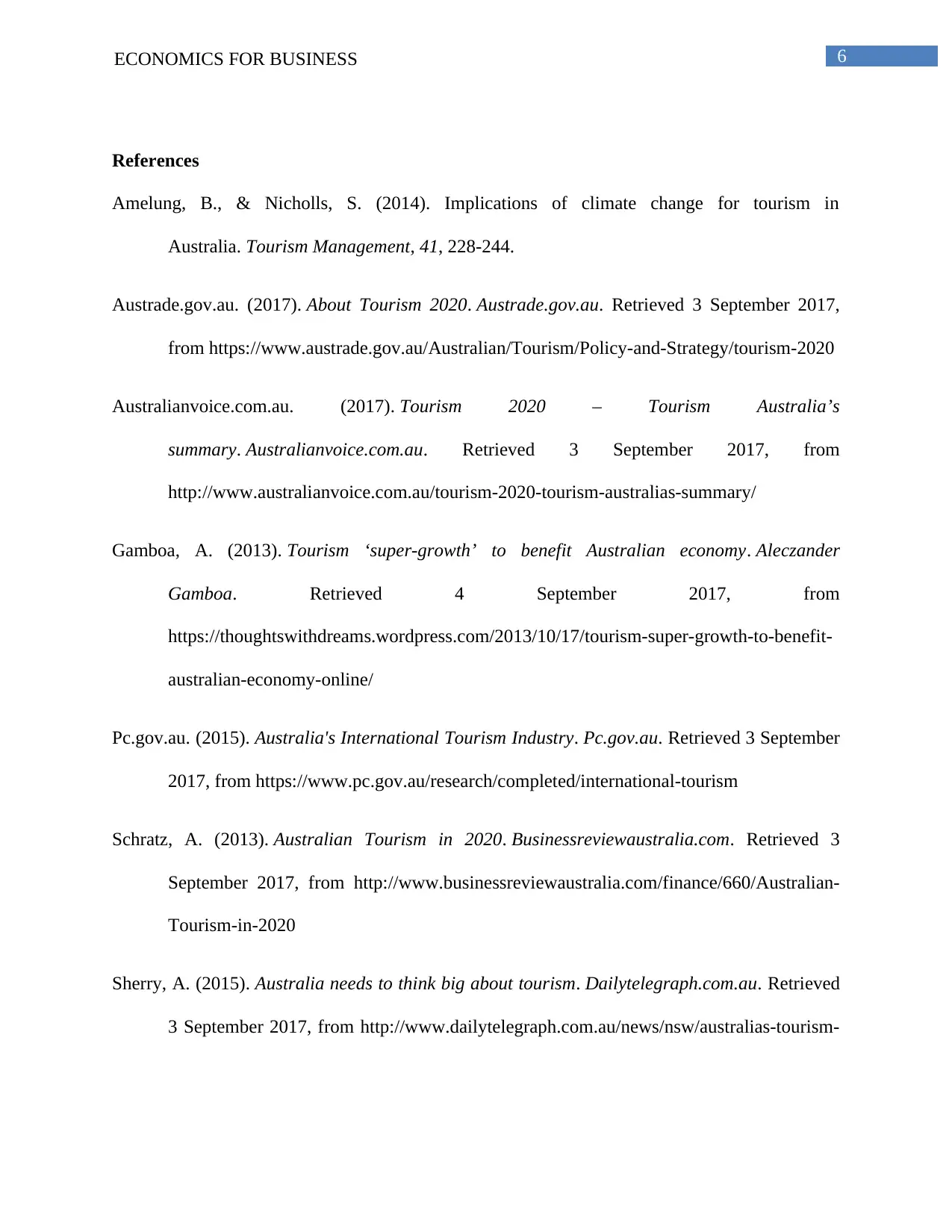
6ECONOMICS FOR BUSINESS
References
Amelung, B., & Nicholls, S. (2014). Implications of climate change for tourism in
Australia. Tourism Management, 41, 228-244.
Austrade.gov.au. (2017). About Tourism 2020. Austrade.gov.au. Retrieved 3 September 2017,
from https://www.austrade.gov.au/Australian/Tourism/Policy-and-Strategy/tourism-2020
Australianvoice.com.au. (2017). Tourism 2020 – Tourism Australia’s
summary. Australianvoice.com.au. Retrieved 3 September 2017, from
http://www.australianvoice.com.au/tourism-2020-tourism-australias-summary/
Gamboa, A. (2013). Tourism ‘super-growth’ to benefit Australian economy. Aleczander
Gamboa. Retrieved 4 September 2017, from
https://thoughtswithdreams.wordpress.com/2013/10/17/tourism-super-growth-to-benefit-
australian-economy-online/
Pc.gov.au. (2015). Australia's International Tourism Industry. Pc.gov.au. Retrieved 3 September
2017, from https://www.pc.gov.au/research/completed/international-tourism
Schratz, A. (2013). Australian Tourism in 2020. Businessreviewaustralia.com. Retrieved 3
September 2017, from http://www.businessreviewaustralia.com/finance/660/Australian-
Tourism-in-2020
Sherry, A. (2015). Australia needs to think big about tourism. Dailytelegraph.com.au. Retrieved
3 September 2017, from http://www.dailytelegraph.com.au/news/nsw/australias-tourism-
References
Amelung, B., & Nicholls, S. (2014). Implications of climate change for tourism in
Australia. Tourism Management, 41, 228-244.
Austrade.gov.au. (2017). About Tourism 2020. Austrade.gov.au. Retrieved 3 September 2017,
from https://www.austrade.gov.au/Australian/Tourism/Policy-and-Strategy/tourism-2020
Australianvoice.com.au. (2017). Tourism 2020 – Tourism Australia’s
summary. Australianvoice.com.au. Retrieved 3 September 2017, from
http://www.australianvoice.com.au/tourism-2020-tourism-australias-summary/
Gamboa, A. (2013). Tourism ‘super-growth’ to benefit Australian economy. Aleczander
Gamboa. Retrieved 4 September 2017, from
https://thoughtswithdreams.wordpress.com/2013/10/17/tourism-super-growth-to-benefit-
australian-economy-online/
Pc.gov.au. (2015). Australia's International Tourism Industry. Pc.gov.au. Retrieved 3 September
2017, from https://www.pc.gov.au/research/completed/international-tourism
Schratz, A. (2013). Australian Tourism in 2020. Businessreviewaustralia.com. Retrieved 3
September 2017, from http://www.businessreviewaustralia.com/finance/660/Australian-
Tourism-in-2020
Sherry, A. (2015). Australia needs to think big about tourism. Dailytelegraph.com.au. Retrieved
3 September 2017, from http://www.dailytelegraph.com.au/news/nsw/australias-tourism-
Paraphrase This Document
Need a fresh take? Get an instant paraphrase of this document with our AI Paraphraser

7ECONOMICS FOR BUSINESS
industry-needs-innovation-and-big-ideas-to-continue-to-grow/news-story/
53078ef6405ad0c433612722c6fdbde7
Tourism Australia. (2017). Tourism 2020. Tourism Australia. Retrieved 3 September 2017, from
http://www.tourism.australia.com/content/dam/assets/document/1/6/w/u/3/2002107.pdf
Tourism.australia.com. (2017). National long-term Tourism Strategy. Tourism Australia.
Retrieved 3 September 2017, from
http://www.tourism.australia.com/content/dam/assets/document/1/6/x/6/k/2002556.pdf
World Bank. (2017). TCdata360: International tourism, number of arrivals. TCdata360.
Retrieved 4 September 2017, from
https://tcdata360.worldbank.org/indicators/ST.INT.ARVL?
country=BRA&indicator=1841&viz=line_chart&years=1995,2015#
industry-needs-innovation-and-big-ideas-to-continue-to-grow/news-story/
53078ef6405ad0c433612722c6fdbde7
Tourism Australia. (2017). Tourism 2020. Tourism Australia. Retrieved 3 September 2017, from
http://www.tourism.australia.com/content/dam/assets/document/1/6/w/u/3/2002107.pdf
Tourism.australia.com. (2017). National long-term Tourism Strategy. Tourism Australia.
Retrieved 3 September 2017, from
http://www.tourism.australia.com/content/dam/assets/document/1/6/x/6/k/2002556.pdf
World Bank. (2017). TCdata360: International tourism, number of arrivals. TCdata360.
Retrieved 4 September 2017, from
https://tcdata360.worldbank.org/indicators/ST.INT.ARVL?
country=BRA&indicator=1841&viz=line_chart&years=1995,2015#
1 out of 8
Related Documents
Your All-in-One AI-Powered Toolkit for Academic Success.
+13062052269
info@desklib.com
Available 24*7 on WhatsApp / Email
![[object Object]](/_next/static/media/star-bottom.7253800d.svg)
Unlock your academic potential
Copyright © 2020–2025 A2Z Services. All Rights Reserved. Developed and managed by ZUCOL.




